|
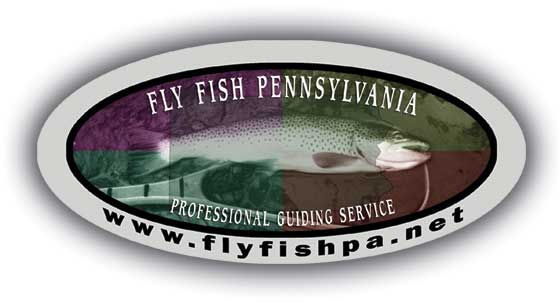
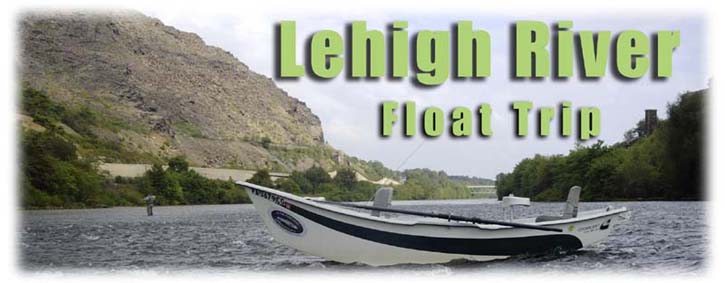
|
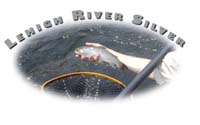
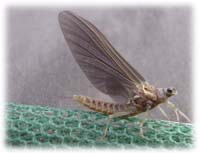
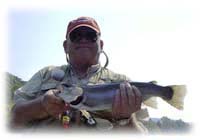
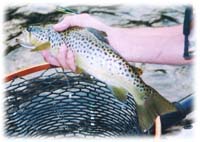
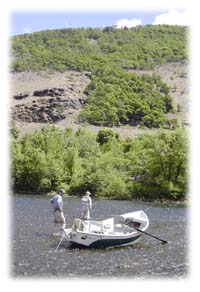
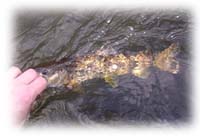
|
The
Lehigh River originates from a series of glacial bogs on the Pocono
Plateau at an elevation of 2,100 feet and flows into the Delaware
River at Easton, PA - elevation of 200 feet. The upper portion
of the Lehigh is considered a coldwater, freestone stream and
has that characteristic Pocono tannic stain. This water flows
into the Francis E Walter dam.
Downstream of the dam, just south of White Haven you have
the Lehigh Gorge and its many coldwater tributaries. This setup
quickly swells the Lehigh into a large and foreboding river by
east coast standards. These coldwater tributaries are also what
maintain the rivers temperatures and allow the trout to holdover
extremely well during the warm weather months. From the bottom
of the Lehigh Gorge at Glen Onoko to the town of Lehighton, the
Lehigh still maintains its burley nature with long, heavy-white-water
rapids, large rocks, pocket water and deep pools. In the Lehighton
to Bowmanstown stretch the river decreases in gradient, but it
still has some class III rapids. In this stretch we tend to find
a combo of deep pools and steep banks. This can provide decent
dry fly fishing during a hatch. From Bowmanstown to Walnutport
the river begins to decrease in gradient. There are still some
heavy whitewater rapids but not near the length as upstream. What
we do find are pools that are long and deep, which provide the
angler an opportunity to target large trout slashing at emerging
caddis or sipping mayflies from the surface film
We tend to focus our trips on the stretches
from Jim Thorpe down to the town of Walnutport. There are 3 stretches of river we will float
in our 16 clackacraft drift boat.
The Lehigh has good populations of wild and stocked trout
that will range from 12 to 20 inches.
But, the Lehigh has the reputation of giving up some very
large fish that can go as big as 28 inches.
What to expect:
Flows/Conditions: In April, May and June (prime
time for the Lehigh) one should expect excellent flows for fishing
depending on the amount of snow run off and precipitation.
The Lehigh is a big and burly river, the majority of the
time is spent fishing out of the drift boat.
There will be locations where gravel bars are present and
we are able to step out stretch our legs and work the water a
bit.
The Day: Under normal conditions, your day will begin
by meeting the guide at the take out location (time and location
to be determined by guide). We
usually like to be on the water no later than 10:30am.
It is our finding that the trout in Lehigh tend to get
more active as the morning hours progress.
Late morning and afternoon can bring hatches of caddis
or mayflies depending on the time of year.
Nymph fishing can be effective in the early morning hours
as well as stripping streamers and wooly buggers off the banks
with mid-morning usually bringing hatching insects along with
the hopes of some rising fish. By Noon or 1pm we will try to take
a break for a streamside lunch (full day floats only) prepared
by the guide. After Lunch we can continue to fish, dry-dropper
rigs can be effective as well as buggers off the banks. All this
leads up to the evening when we prepare for increasing concentrations
of hatching mayflies and/or a spinner fall.
During May and June the Sulphurs and Olives hatch in large
numbers bringing up virtually every fish in the river. On these
nights we usually we don't get off the water until dark.
Package includes:
*day
of guided fishing
*Stream-side Lunch (Full day) with drinks provided. ½ day trips include snacks and drinks.
*Arrival time to be coordinated with the guide depending on conditions
- directions will be provided upon booking
Gear requirements:
Fly Rods - 5wt or 6wgt x 8'6"-9
preferred. (Bring two
rods if possible one rigged with floating line and the other with
a sinking line)
Line - weight forward floating to match rod and a sinking line
(150 grains) to fish streamers & buggers
Leaders - 9' to 5lb (conditions will determine tippets used -
3x or 4x is the norm)
Waders Chest waders (light weight breathable preferred )
Boots - Felt soled or Aqua stealth a minimum NO studs permitted
in boat.
Collapsible wading staff, rain jacket, gloves, warm hat &
clothing, water bottle, bug spray, sunglasses, etc.
DONT forget the camera......the scenery
is spectacular!!!!!!!!!!!!!!!!
For
questions on any of the above please contact us.
For
a complete selection of everything you will ever need to tame
the Lehigh,
check out TCO Fly Shop

|
|
BUG
LIST
April
(rain and temperature pending)
Bugs to expect to see hatching and flies to be used.
|
|
Dries (Spinner & Duns)
|
|
Lil
Black Stones (14), Green Body Caddis (14-16), Blue Winged Olives
(#20-24), Midges (18-26), Craneflies
(14-16)
Hendrickson (14), Quill
Gordons (14), Blue Quills (18)
|
|
Nymphs
|
|
March
Brown (14), Sulphur (14-16), Green Caddis Pupae (14-16), midge
larva (18), Stone Flies (6-10), Little Black Stones (12-14)
|
|
Searching/Attractor Patterns
|
|
Nitro (16-20),
Shop-vac (16-20), Gold Ribbed Hares Ear (12-16), Pheasant Tail
(12-16), Bead Head /Gold Ribbed Peacock Caddis Worm (14), Bead
Head Caddis (14-16), Muskrat Nymphs (14-16)
|
|
Streamer Patterns
|
|
Wooly Buggers (6-8) in olive, brown, black Clouser minnows
in various colorations (8)
|
|
May
(rain and temperature pending)
Bugs to expect to see hatching and flies to be used.
|
|
Dries (Spinner & Duns)
|
|
Sulphurs (14-16), Green Body Caddis (14-16),
Blue Winged Olives
(#20-24), Midges (18-26), Craneflies (14-16)
Hendrickson (14), Quill Gordons (14), March Browns (12)
|
|
Nymphs
|
|
March Brown (14), Sulphur
(14-16), Green Caddis Pupae (14-16), midge larva (18), Stone Flies
(6-10),
|
|
Searching/Attractor Patterns
|
|
Nitro (16-20),
Shop-vac (16-20), Gold Ribbed Hares Ear (12-16), Pheasant Tail
(12-16), Bead Head /Gold Ribbed Peacock Caddis Worm (14), Bead
Head Caddis (14-16), Muskrat Nymphs (14-16)
|
|
Streamer Patterns
|
|
Wooly Buggers (6-8) in olive, brown, black Clouser minnows
in various colorations (8) Big Soft Hackle Wet Flies (8-10)
|
|
June
(rain and temperature pending)
Bugs to expect to see hatching and flies to be used.
|
|
Dries (Spinner & Duns)
|
|
Sulphurs (14-16), Green Body Caddis (14-16),
Blue Winged Olives
(#20-24), Midges (18-26), Craneflies (14-16)
Olives (14), Slate Drakes (12-14),
|
|
Nymphs
|
|
Isonychia (14), Sulphur (14-16),
Green Caddis Pupae (14-16), midge larva (18), Stone Flies (6-10),
|
|
Searching/Attractor Patterns
|
|
Nitro (16-20),
Shop-vac (16-20), Gold Ribbed Hares Ear (12-16), Pheasant Tail
(12-16), Bead Head /Gold Ribbed Peacock Caddis Worm (14), Bead
Head Caddis (14-16), Muskrat Nymphs (14-16)
|
|
Streamer Patterns
|
|
Wooly Buggers (6-8) in olive, brown, black Clouser minnows
in various colorations (8) Big Soft Hackle Wet flies (8-10)
|
|